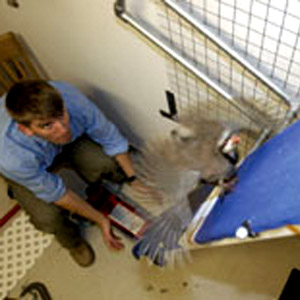Pratique | Débuter
L’orientation idéale de l’aile : une nouvelle théorie pour expliquer l’apparition du vol

L’étudiant Matt Bundle de l’Univesrité du Montana (Etats-Unis) lâche une Perdrix choukar (Alectoris chukar) sur une rampe quasiment verticale : elle utilise ses ailes comme les « spoilers » d’une voiture de course pour l’aider à garder ses pattes sur la surface.Source : Research View / University of Montana
Introduction
La théorie de l’apparition du vol fait l’objet de discussions entre biologistes depuis près de 150 ans : certains estiment que les ancêtres des oiseaux ont appris à voler en grimpant aux arbres et en planant de branche en branche, d’autres que c’est en courant et en agitant leurs avants-bras qu’ils ont finalement réussit à décoller.
Mais des biologistes de l’université du Montana aux Etats-Unis ont noté que des poussins âgés d’un jour de Perdrix choukar étaient capables de franchir des pentes de 60° (jusqu’à 105° chez les adultes!), pour échapper à des prédateurs par exemple. Le secret de cet exploit est qu’elles tiennent leurs ailes inclinées selon un angle optimal par rapport au sol afin d’augmenter leur prise au sol et de générer une force aérodynamique. L’aile fait ainsi en quelque sorte office de « spoiler » (d’aileron), comme dans une voiture de sport.
La capacité à voler serait ainsi née chez les ancêtres des oiseaux devant escalader des obstacles quasi-verticaux pour échapper à leurs prédateurs.
Abstract
The evolution of avian flight remains one of biology’s major controversies, with a long history of functional interpretations of fossil forms given as evidence for either an arboreal or cursorial origin of flight.
Biologists of the Montana University noticed that ground-dwelling birds like Chukars can master 60-degree slopes as early as the day after hatching to escape predators for example. The team discovered that the secret of this behaviour, and flight itself, begins with learning the optimal wing-to-ground angle needed to generate force. They use their wings like the spoiler on a race car to stick their feet to the ground and both young and adult birds use the same angle, a fundamental avian wing-stroke, for many types of locomotion leading up to level flight. Bird ancestors could have flapped their proto-wings to help them run up extremely steep surfaces, giving them a survival advantage. And eventually these wings evolved to the point they became strong enough to allow true flight.
Poursuivez la lecture de cet article, en vous abonnant dès maintenant !
Découvrez les Archives d’Ornithomedia.com
Pour seulement 10,00 €TTC/an (ou 6,00 € les 6 mois)
Profitez de plusieurs centaines d’articles en accès illimité et sans aucun engagement.
Compléments
Ouvrages recommandés
- Taking Wing: Archaeopteryx and the Evolution of Bird Flight de Pat Shipman
- Dinosaurs of the Air: The Evolution and Loss of Flight in Dinosaurs and Birds de Gregory S. Paul
Sources
- Cary Shimek. Running Straight Up. Research View. www.umt.edu/urelations/rview/winter04/flight.htm
- Kenneth P. Dial, Brandon E. Jackson & Paolo Segre: « A fundamental avian wing-stroke provides a new perspective on the evolution of flight », Nature (23 janvier 2008)
- National Géographic: « Running Straight Up: UM Scientist May Have Found Missing Link in Evolution of Flight »




Aucun commentaire sur ce sujet
Participer à la discussion !